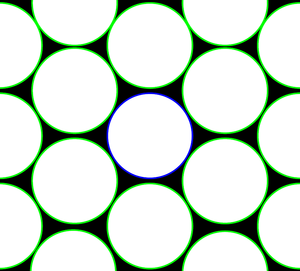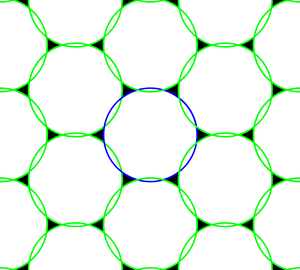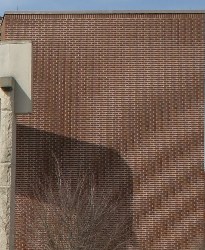Multidimensional sampling
Indigital signal processing,multidimensional samplingis the process of converting a function of a multidimensional variable into a discrete collection of values of the function measured on a discrete set of points. This article presents the basic result due to Petersen and Middleton[1]on conditions for perfectly reconstructing awavenumber-limited function from its measurements on a discretelatticeof points. This result, also known as thePetersen–Middleton theorem,is a generalization of theNyquist–Shannon sampling theoremfor sampling one-dimensionalband-limitedfunctions to higher-dimensionalEuclidean spaces.
In essence, the Petersen–Middleton theorem shows that a wavenumber-limited function can be perfectly reconstructed from its values on an infinite lattice of points, provided the lattice is fine enough. The theorem provides conditions on the lattice under which perfect reconstruction is possible.
As with the Nyquist–Shannon sampling theorem, this theorem also assumes an idealization of any real-world situation, as it only applies to functions that are sampled over an infinitude of points. Perfect reconstruction is mathematically possible for the idealized model but only an approximation for real-world functions and sampling techniques, albeit in practice often a very good one.
Preliminaries[edit]
This section includes alist of references,related reading,orexternal links,but its sources remain unclear because it lacksinline citations.(October 2014) |


The concept of abandlimitedfunction in one dimension can be generalized to the notion of a wavenumber-limited function in higher dimensions. Recall that theFourier transformof an integrable functiononn-dimensional Euclidean space is defined as:
wherexandξaren-dimensionalvectors,andis theinner productof the vectors. The functionis said to be wavenumber-limited to a setif the Fourier transform satisfiesfor.
Similarly, the configuration of uniformly spaced sampling points in one-dimension can be generalized to alatticein higher dimensions. A lattice is a collection of pointsof the form where {v1,...,vn} is abasisfor.Thereciprocal latticecorresponding tois defined by
where the vectorsare chosen to satisfy.That is, if the vectorsform columns of a matrixandthe columns of a matrix,then.An example of a sampling lattice in two dimensional space is ahexagonal latticedepicted in Figure 1. The corresponding reciprocal lattice is shown in Figure 2. The reciprocal lattice of asquare latticein two dimensions is another square lattice. In three dimensional space the reciprocal lattice of a face-centered cubic (FCC) latticeis a body centered cubic (BCC) lattice.
The theorem[edit]
Letdenote a lattice inandthe corresponding reciprocal lattice. The theorem of Petersen and Middleton[1]states that a functionthat is wavenumber-limited to a setcan be exactly reconstructed from its measurements onprovided that the setdoes not overlap with any of its shifted versionswhere the shiftxis any nonzero element of the reciprocal lattice.In other words,can be exactly reconstructed from its measurements onprovided thatfor all.
Reconstruction[edit]

The generalization of thePoisson summation formulato higher dimensions[2]can be used to show that the samples,,of the functionon the latticeare sufficient to create aperiodic summationof the function.The result is:
| (Eq.1) |
whererepresents the volume of theparallelepipedformed by the vectors {v1,...,vn}. This periodic function is often referred to as the sampled spectrum and can be interpreted as the analogue of thediscrete-time Fourier transform(DTFT) in higher dimensions. If the original wavenumber-limited spectrumis supported on the setthen the functionis supported on periodic repetitions ofshifted by points on the reciprocal lattice.If the conditions of the Petersen-Middleton theorem are met, then the functionis equal tofor all,and hence the original field can be exactly reconstructed from the samples. In this case the reconstructed field matches the original field and can be expressed in terms of the samples as
| , | (Eq.2) |
whereis the inverse Fourier transform of thecharacteristic functionof the set.This interpolation formula is the higher-dimensional equivalent of theWhittaker–Shannon interpolation formula.
As an example suppose thatis a circular disc. Figure 3 illustrates the support ofwhen the conditions of the Petersen-Middleton theorem are met. We see that the spectral repetitions do not overlap and hence the original spectrum can be exactly recovered.
Implications[edit]
Aliasing[edit]



The theorem gives conditions on sampling lattices for perfect reconstruction of the sampled. If the lattices are not fine enough to satisfy the Petersen-Middleton condition, then the field cannot be reconstructed exactly from the samples in general. In this case we say that the samples may bealiased.Again, consider the example in whichis a circular disc. If the Petersen-Middleton conditions do not hold, the support of the sampled spectrum will be as shown in Figure 4. In this case the spectral repetitions overlap leading to aliasing in the reconstruction.
A simple illustration of aliasing can be obtained by studying low-resolution images. A gray-scale image can be interpreted as a function in two-dimensional space. An example of aliasing is shown in the images of brick patterns in Figure 5. The image shows the effects of aliasing when the sampling theorem's condition is not satisfied. If the lattice of pixels is not fine enough for the scene, aliasing occurs as evidenced by the appearance of theMoiré patternin the image obtained. The image in Figure 6 is obtained when a smoothened version of the scene is sampled with the same lattice. In this case the conditions of the theorem are satisfied and no aliasing occurs.
Optimal sampling lattices[edit]
One of the objects of interest in designing a sampling scheme for wavenumber-limited fields is to identify the configuration of points that leads to the minimum sampling density, i.e., the density of sampling points per unit spatial volume in.Typically the cost for taking and storing the measurements is proportional to the sampling density employed. Often in practice, the natural approach to sample two-dimensional fields is to sample it at points on arectangular lattice.However, this is not always the ideal choice in terms of the sampling density. The theorem of Petersen and Middleton can be used to identify the optimal lattice for sampling fields that are wavenumber-limited to a given set.For example, it can be shown that the lattice inwith minimum spatial density of points that admits perfect reconstructions of fields wavenumber-limited to a circular disc inis the hexagonal lattice.[3]As a consequence, hexagonal lattices are preferred for samplingisotropic fieldsin.
Optimal sampling lattices have been studied in higher dimensions.[4]Generally, optimalsphere packinglattices are ideal for sampling smooth stochastic processes while optimal sphere covering lattices[5]are ideal for sampling rough stochastic processes.
Since optimal lattices, in general, are non-separable, designinginterpolationandreconstruction filtersrequires non-tensor-product (i.e., non-separable) filter design mechanisms.Box splinesprovide a flexible framework for designing such non-separable reconstructionFIRfilters that can be geometrically tailored for each lattice.[6][7]Hex-splines[8]are the generalization ofB-splinesfor 2-D hexagonal lattices. Similarly, in 3-D and higher dimensions, Voronoi splines[9]provide a generalization ofB-splinesthat can be used to design non-separable FIR filters which are geometrically tailored for any lattice, including optimal lattices.
Explicit construction of ideal low-pass filters (i.e.,sincfunctions) generalized to optimal lattices is possible by studying the geometric properties ofBrillouin zones(i.e.,in above) of these lattices (which arezonotopes).[10]This approach provides a closed-form explicit representation offor general lattices, including optimal sampling lattices. This construction provides a generalization of theLanczos filterin 1-D to the multidimensional setting for optimal lattices.[10]
Applications[edit]
The Petersen–Middleton theorem is useful in designing efficient sensor placement strategies in applications involving measurement of spatial phenomena such as seismic surveys, environment monitoring and spatial audio-field measurements.[11]
References[edit]
- ^abD. P. Petersen and D. Middleton, "Sampling and Reconstruction of Wave-Number-Limited Functions in N-Dimensional Euclidean Spaces", Information and Control, vol. 5, pp. 279–323, 1962.
- ^E. M. Stein and G. Weiss, "Introduction to Fourier Analysis on Euclidean Spaces", Princeton University Press, Princeton, 1971.
- ^D. R. Mersereau, “The processing of hexagonally sampled two-dimensional signals,” Proceedings of the IEEE, vol. 67, no. 6, pp. 930 – 949, June 1979.
- ^Kunsch, H. R.; Agrell, E.; Hamprecht, F. A. (2005)."Optimal Lattices for Sampling".IEEE Transactions on Information Theory.51(2): 634.doi:10.1109/TIT.2004.840864.
- ^J. H. Conway, N. J. A. Sloane. Sphere packings, lattices and groups. Springer, 1999.
- ^A. Entezari. Optimal sampling lattices and trivariate box splines. [Vancouver, BC.]: Simon Fraser University, 2007. <http://summit.sfu.ca/item/8178>.
- ^Entezari, A.; Van De Ville, D.; Moller, T. (2008). "Practical Box Splines for Reconstruction on the Body Centered Cubic Lattice".IEEE Transactions on Visualization and Computer Graphics.14(2): 313–328.CiteSeerX10.1.1.330.3851.doi:10.1109/TVCG.2007.70429.PMID18192712.
- ^Van De Ville, D.; Blu, T.; Unser, M.; Philips, W.; Lemahieu, I.; Van De Walle, R. (2004)."Hex-Splines: A Novel Spline Family for Hexagonal Lattices".IEEE Transactions on Image Processing.13(6): 758–772.Bibcode:2004ITIP...13..758V.doi:10.1109/TIP.2004.827231.PMID15648867.
- ^Mirzargar, M.; Entezari, A. (2010). "Voronoi Splines".IEEE Transactions on Signal Processing.58(9): 4572.Bibcode:2010ITSP...58.4572M.doi:10.1109/TSP.2010.2051808.
- ^abYe, W.; Entezari, A. (2012). "A Geometric Construction of Multivariate Sinc Functions".IEEE Transactions on Image Processing.21(6): 2969–2979.Bibcode:2012ITIP...21.2969Y.doi:10.1109/TIP.2011.2162421.PMID21775264.
- ^Bardan, V. (2007-06-11)."The Petersen-Middleton Theorem and Sampling of Seismic Data".69th EAGE Conference and Exhibition incorporating SPE EUROPEC 2007.European Association of Geoscientists & Engineers. pp. cp.doi:10.3997/2214-4609.201401831.ISBN978-90-73781-54-2.


































